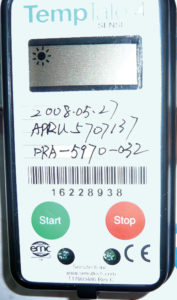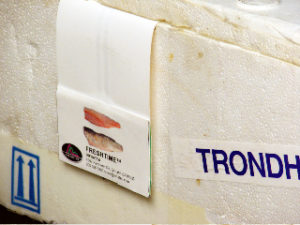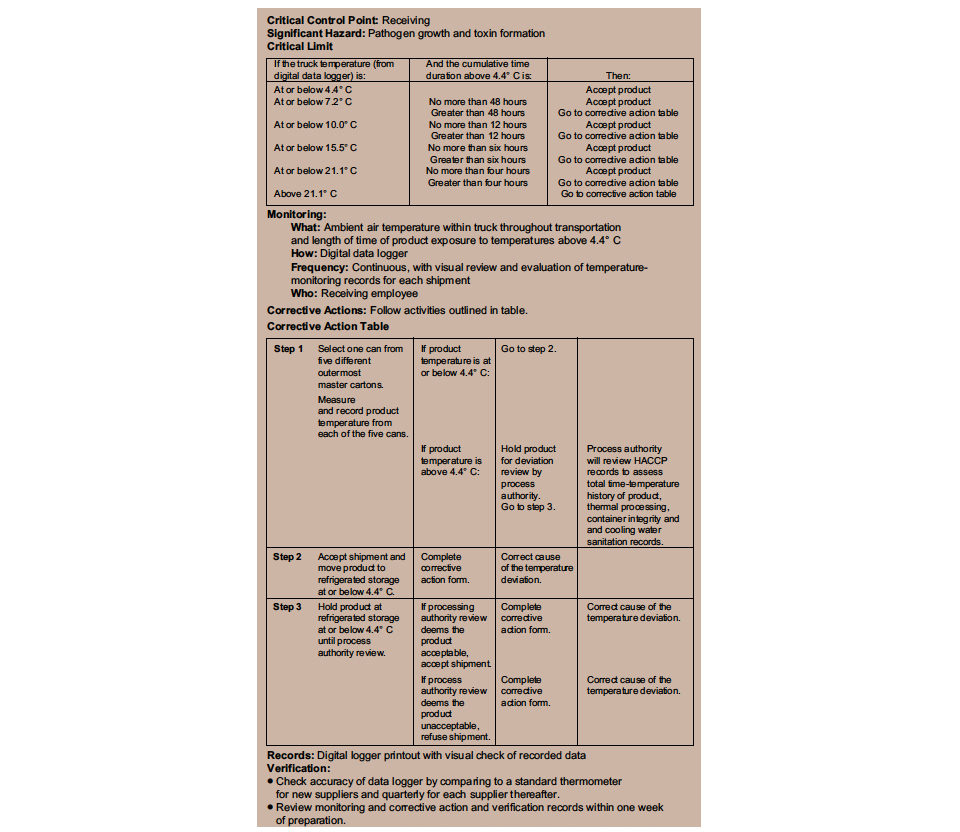HACCP monitoring challenge

in shipping containers. Photo courtesy of Sensitech Corp.
Like many other foods, seafoods are increasingly sourced and shipped globally to numerous markets in both traditional importing countries like the United States, Europe and Japan, and countries experiencing rapid growth, like China and even Russia. Virtually all receiving countries and commercial customers now require hazard analysis critical control point (HACCP) controls for assuring the safety of the products they buy.
Time-, temperature-sensitive products
Seafoods requiring time/temperature controls in transit include refrigerated vacuum-packaged fresh or smoked fish, histamine-forming species such as mahi-mahi and tuna, and those receiving a moderate terminal heating step, like pasteurized crabmeat. Pasteurized crab products are of primary concern since few other refrigerated (not shelf-stable, unfrozen) seafoods have the required shelf life for international shipment.
Although these products receive a thermal process adequate for the destruction of most spoilage and disease-causing bacteria, they must be held under refrigeration to prevent the growth of the limited number of pathogens capable of surviving the pasteurization process, notably proteolytic strains of Clostridium botulinum bacteria, the organism responsible for botulism, and Bacillus cereus bacteria. The industry is very aware of the importance of tight temperature controls to maintain high quality as well as food safety assurance, and the safety record for these products is excellent.
HACCP plans for pasteurized crabmeat imported into the U.S. commonly include a temperature limit of 4.4 degrees-C during shipping and subsequent storage before distribution. The time allowed above this temperature is typically four hours. This restriction may be unnecessarily conservative for food safety and appears to have originated from a misinterpretation of the U.S. Food and Drug Administration (FDA) Fish and Fisheries Products Hazards and Controls Guidance documents.
Practical controls

Intrafab, Inc.
U.S. importers and distributors are working with FDA and the National Seafood HACCP Alliance to find more practical recommendations for shipping and storage of pasteurized crabmeat.
The National Fisheries Institute wrote the FDA with concerns, noting that its guide recommends a maximum cooler temperature of 4.4 degrees-C for a critical limit to control the growth of pathogens. FDA also recognizes that when refrigerated fishery products are transported from processor to processor only a short distance (four hours or less travel time), continuous monitoring of temperature would not be required.
“We believe that these two separate expectations have been combined into a de facto critical limit which results in product being automatically rejected if the refrigeration temperature exceeds 40 degrees-F (4.4 degrees-C) for more than four hours,” NFI wrote.
There are various approaches for building less-restrictive critical limits and corrective actions into a HACCP plan, all based on the use of a continuous record of shipping/storage temperatures for evaluating critical limits. One example that could be incorporated into a HACCP plan is presented in Fig. 1. Contact the main author for important details before implementing this strategy.

Monitoring
With the international expansion in the use of HACCP, a wide variety of temperature-monitoring and recording devices have come to market in recent years. Most are small digital loggers that can be activated when a shipping container is filled and then downloaded by computer and read at receipt. Other types of recorders are also available, from mechanical paper chart recorders to sophisticated radio-frequency identification (RFID) devices.
A complicating factor is that shipping containers are frequently delivered to public cold storage facilities, where they may be divided into 50 or more orders and delivered by various trucking companies, usually common carriers. The original temperature recorders are often returned to the U.S. importers and, although recorders are normally installed on trucks, no continuous temperature record is available from foreign production plant to final customer.
HACCP plans, including those that allow for multiple time and temperature combinations, work best when the complete time/temperature history is known in detail, especially when determining appropriate corrective actions. This is because time/temperature abuse is additive. Relatively minor temperature spikes at several locations in the distribution chain could potentially breach overall critical limits even if each event is independently passable.
RFIDs
Recent advances in RFID technology may finally solve this problem. These devices emit a radio frequency containing product code, date/time, location, temperature and other information that can be read by scanners. About the size of a credit card, they can accompany products along their entire route as long as the tagged products are scanned.
The problem of multiple small deliveries can be addressed by transferring the information from the original foreign shipment tags to a set of tags that accompany each small subshipment. This process can be repeated if customers want to use the tags to monitor their own deliveries.
Anyone with authorized access can view the history of the products via the Internet. Confidentiality concerns between buyer and seller can be addressed by limiting the amount of information available to specified users. For example, the entire time-temperature history might be available to the foreign packer and U.S. importer, while only the history since release from U.S. cold storage might be viewable by each customer for the products they ordered.
To simplify things further, customers might simply view light-emitting diode lamps on the card at receipt indicating “pass” or “fail” for identified parameters. Many combinations are possible. The histories of numerous loads can be viewed from computers or handheld devices and easily organized electronically. The cost of RFID scanners is coming down, making what until recently was an intriguing but impractical technology an economically feasible option for seafood importers and distributors.
(Editor’s Note: This article was originally published in the November/December 2008 print edition of the Global Aquaculture Advocate.)
Now that you've finished reading the article ...
… we hope you’ll consider supporting our mission to document the evolution of the global aquaculture industry and share our vast network of contributors’ expansive knowledge every week.
By becoming a Global Seafood Alliance member, you’re ensuring that all of the pre-competitive work we do through member benefits, resources and events can continue. Individual membership costs just $50 a year. GSA individual and corporate members receive complimentary access to a series of GOAL virtual events beginning in April. Join now.
Not a GSA member? Join us.
Authors
-
Thomas E. Rippen
Maryland Sea Grant Extension Program
Center for Food Science and Technology
University of Maryland Eastern Shore
Princess Anne, Maryland 21853 USA -
Lisa Weddig
Director
Regulatory and Technical Affairs
National Fisheries Institute
McLean, Virginia, USA
Related Posts

Health & Welfare
10 paths to low productivity and profitability with tilapia in sub-Saharan Africa
Tilapia culture in sub-Saharan Africa suffers from low productivity and profitability. A comprehensive management approach is needed to address the root causes.

Aquafeeds
A look at corn distillers dried grains with solubles
Corn distillers dried grains with solubles are an economical source of energy, protein and digestible phosphorus to reduce feed costs and fishmeal usage.

Aquafeeds
A look at protease enzymes in crustacean nutrition
Food digestion involves digestive enzymes to break down polymeric macromolecules and facilitate nutrient absorption. Enzyme supplementation in aquafeeds is a major alternative to improve feed quality and nutrient digestibility, gut health, compensate digestive enzymes when needed, and may also improve immune responses.

Intelligence
As ocean temperatures rise, so too will vibrio outbreaks
A study using a half-century of data has linked climate change and warming sea temperatures with an increase in illnesses from the common vibrio bacteria. Shellfish growers, fighting a particularly virulent strain of Vibrio parahaemolyticus, are changing their harvest protocols.


